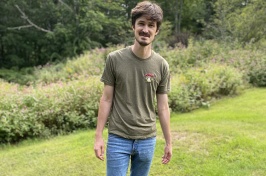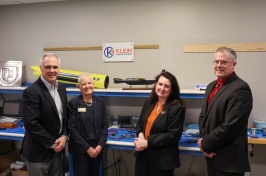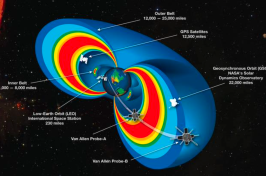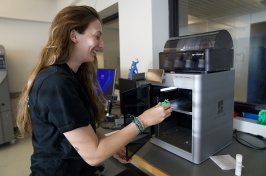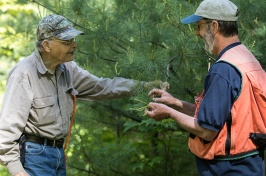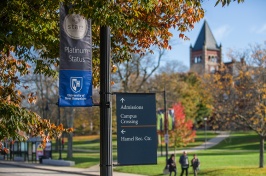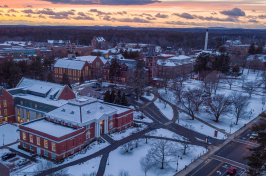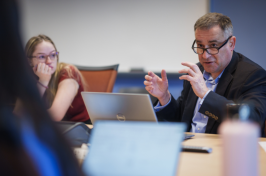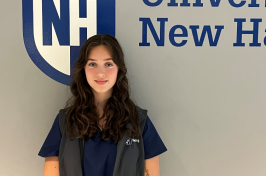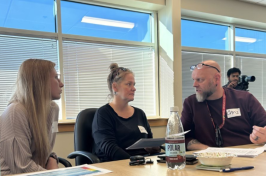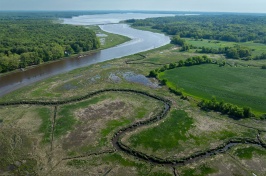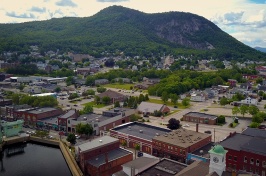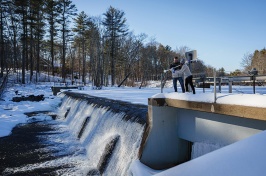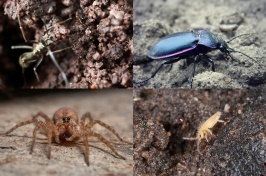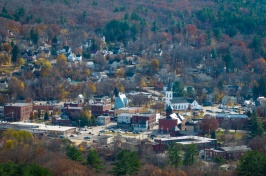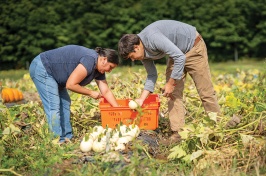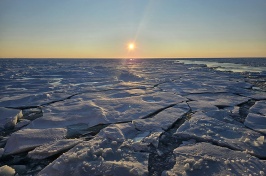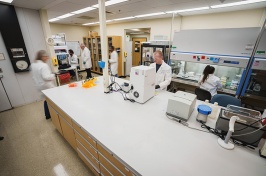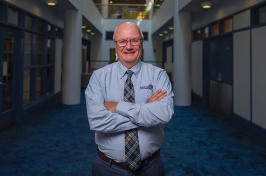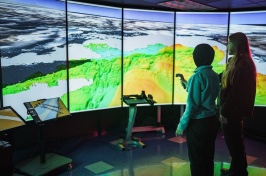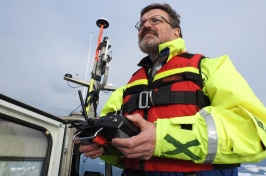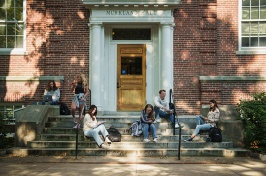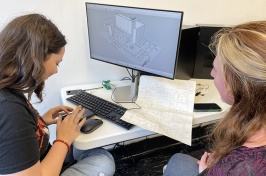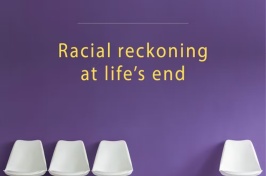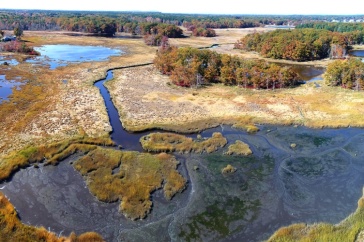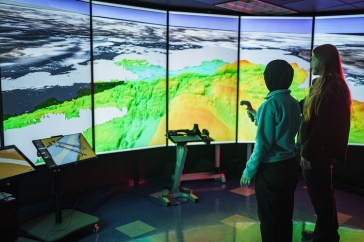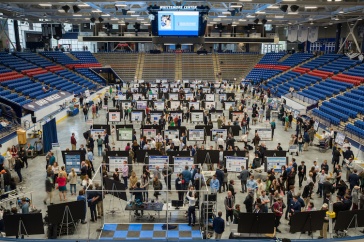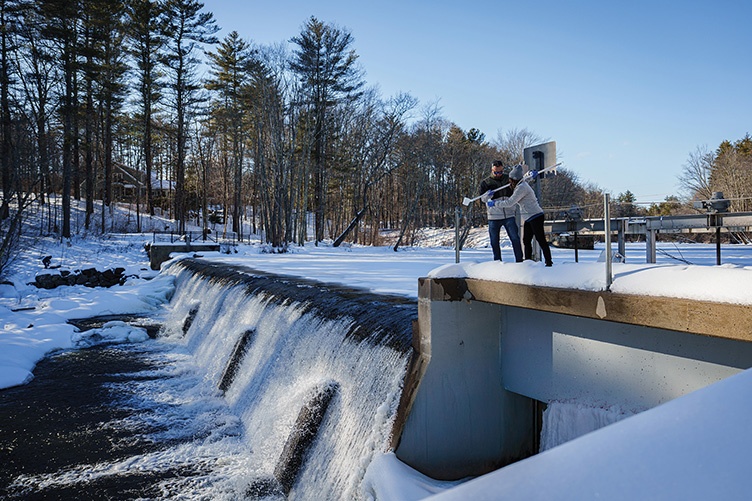
PFAS researchers Adam Wymore and Paula Mouser sample the Lamprey River near Durham.
For a time, UNH researchers Paula Mouser and Adam Wymore were connected only by the invisible chemicals they were studying.
That is, Mouser, a professor of civil and environmental engineering, and Wymore, associate professor of natural resources and the environment, had both independently worked on research tackling the impact of pollution. Mouser’s recent work focused specifically on PFAS — toxic substances found in many industrial and consumer products known as “forever chemicals” for their persistence in the environment.
When the opportunity to join forces on a project combatting PFAS arose through a grant from the New Hampshire Agriculture Experiment Station focused specifically on interdisciplinary projects, the pair jumped at it. It wasn’t the combined research capacity that was most invigorating, though, but rather the potential power of blending ideologies and outlooks.
“When I saw the call for proposals in that collaborative space, I thought, let’s combine the ways we think about the world,” Wymore says.
Mouser thinks about the world from the “chemistry side of things,” Wymore says, and brought extensive expertise in the ways that PFAS molecules interact with microbial communities. Wymore’s expertise, on the other hand, lies in watersheds and considering the ways in which pollutants enter, move through and are exported from systems.
HOW DID YOU FIND YOUR SPARK?
Paula Mouser
I grew up in Wyoming, which has some of the most breathtaking mountains and open ranges on Earth. This beauty is in stark contrast to the exploitation of natural resources that occurs across the state and largely drives its economy. In college, I was driven to understand how controls on pollution could help preserve these beautiful places.
Adam Wymore
Streams and rivers have always connected me to the landscape and given me a strong sense of place. As a child and young adult paddling whitewater on the Saco River in Maine, the Rio Grande in New Mexico or the Housatonic River in Connecticut … to completing my dissertation work on Oak Creek in Arizona. And my last name is a reference to the Wye River in Wales. Over time I developed a sense of responsibility to understand these environments and care for our freshwater resources at both local and global scales.
The result is a project measuring PFAS (which stands for per- and polyfluoroalkyl substances) levels in precipitation, agricultural soils and a regional watershed to better understand the concentration and deposition of these chemicals in the landscape. The researchers are looking at a focused list of 40 PFAS that move through the environment in precipitation and runoff, particularly in a southeastern New Hampshire watershed. Understanding the magnitude of PFAS from precipitation is important on multiple levels — for residents concerned about the safety and quality of drinking water, and for water treatment plants that will encounter PFAS that make their way to surface water.
“The underlying directive of our work is to try to characterize these background or ambient levels of PFAS in precipitation and look at how land use affects those levels,” Mouser says.
This interdisciplinary approach has allowed both researchers to help lead the charge on an issue increasingly in the spotlight.
“It allowed us to connect on a conceptual framework about how we think about the environment,” Wymore says. “It’s a really exciting space for us to collaborate in.”
“It’s really about educating each other — on the sample sites from his side, and then also the appropriate sampling approach from my side. So, there’s been a lot of great interaction,” Mouser says.
Funding for the research Mouser and Wymore are tackling covered the inclusion of two graduate students, Katherine Wieck and Bailey Mullins, which is significant in that it “enables the next generation of scientists to be explicitly trained in this interdisciplinary space,” Wymore says.
Mouser and Wymore aren’t alone at UNH in terms of teaming up across the disciplines to investigate PFAS.
Scott Lemos, senior lecturer of business administration, and John Halstead, professor of environmental economics, partnered on a study that found that households on public water systems are willing to pay an average of $13.07 a month, or $156.84 annually, on their monthly bills to protect themselves from PFAS.
“The biggest takeaway is that clean drinking water matters deeply to people, and they’re willing to pay to protect it,” Lemos says.
“PFAS isn’t just an environmental issue — it touches public health, economics and even housing. Bringing together people with different expertise means we can see the whole picture.”
Lemos and Halstead both say they similarly benefited from the synergy of their areas of focus.
“It’s really important that physical scientists understand the human element of exposure to substances like PFAS. Likewise, it’s impossible for social scientists to work with the public and policy makers if they don’t know at least enough about the underlying science to know what questions to ask,” Halstead says.
Adds Lemos: “The interdisciplinary approach is everything. PFAS isn’t just an environmental issue — it touches public health, economics, and even housing. Bringing together people with different expertise means we can see the whole picture.”
Thanks in no small part to UNH research efforts, New Hampshire is among the national leaders in monitoring and regulating PFAS. But the researchers envision their work reaching beyond the Granite State.
“I think it’s about informing the conversation at a really local scale, but there haven’t been many of these types of precipitation studies done within the United States, so I think we can help inform some of that conversation, too,” says Mouser.
That intersection of local and global impact helps drive the excitement around finding solutions to PFAS, as the researchers contribute to an issue in their own community while moving a larger discussion forward and positioning UNH as a trailblazer in that space.
“If we can be leaders in that way, if we can help people understand and develop these protocols, it could have broadly applicable results. It’s a global issue, but it will become a global solution, too,” Wymore says. “It’s a really nice example of something that is locally relevant but that you have to think globally about at the same time. All of our communities are connected to each other, and we have an impact on one another even if we’re not right next door.”
-
Written By:
Keith Testa | UNH Marketing | keith.testa@unh.edu





